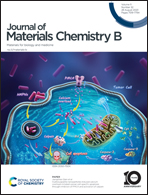A novel recyclable hemoperfusion adsorbent based on TiO2 nanotube arrays for the selective removal of β2-microglobulin†
Abstract
Prolonged and excessive accumulation of β2-microglobulin (β2m) in the blood can lead to various kidney-related and other diseases. Currently, the most effective method of removing β2m from the blood is hemoperfusion. Although some traditional hemoperfusion adsorbents such as cellulose and polystyrene microspheres have been used for the removal of β2m, their selectivity still needs improvement. Immunosorbents have been developed to address this issue, but high cost and limited application are concerns. TiO2 nanotube arrays (TNTAs) have shown great potential in adsorption-related biomedical applications. In this study, we designed and developed a novel TNTA-based hemoperfusion adsorbent for the removal of β2m, which has demonstrated good biocompatibility, selectivity, and reusability. We investigated the β2m adsorption capacities of TNTAs with different pore sizes. The results indicate that TNTAs with a pore size matching the size of β2m exhibit higher adsorption capacity while also having lower adsorption capacity for albumin, showing the importance of pore size on the selectivity of adsorbents. Additionally, green regeneration of TNTAs is achieved via the photocatalytic activity originating from TiO2. Even after five cycles, the adsorption capacity of TNTAs remained above 70%. Our work demonstrates that inorganic materials with ordered pores are capable to be candidates for hemoperfusion, possessing advantages over traditional organic materials such as high stability, security, and low cost.



 Please wait while we load your content...
Please wait while we load your content...